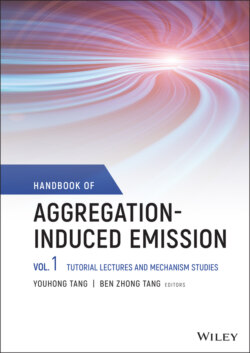Читать книгу Handbook of Aggregation-Induced Emission, Volume 1 - Группа авторов - Страница 27
1.7 Perspective
ОглавлениеTraditional photophysical research usually targets highly rigid and conjugated chromophores. However, investigation of the relationship between molecular motions with the excited‐state decay process as well as manipulation of molecular motions in different manners and multiple states has been a consistent topic in the AIE mechanistic research [23]. From tremendous experimental and theoretical contributions, RIM has been concluded as the general working principle, or the restriction of EVC in the quantum view [6, 7]. AIEgens own high performance in the aggregate or solid state that can hamper the internal conversion between excited states, in which the Kasha’s rule may be invalid [11]. In light of this, the multistate mechanistic model, involving emissive excited states and transition‐forbidden states, has offered perspectives in exploring the nature of higher excited states in the AIE process. In fact, multiple excited states can be involved in the photophysical process of AIEgens, especially for the heteroatom‐containing systems. The proximity effect between the excited states with different property tends to induce the mixing of the states and finally leads to the crossing between dark states (CT, (n, n*), triplet states, etc.) and bright states [19]. The aggregate effect can render repopulation of the excited species, which may make the photophysical processes more complicated than those predicted by the classical luminescence theories [9]. Furthermore, the current RIM mechanistic model mainly focuses on the single‐molecule property, whereas the surrounding molecules serve as the environmental constraint. Hence, more accurate and general theoretical models for the aggregate are still highly desired that consider adequate multistate properties and diverse intermolecular interactions.
Recently, research on the CTE has substantially expanded the mechanistic scope into the aggregate science, that the efficient light emission can be achieved through the clusterization of nonconjugated subunits [21]. Although the power source of CTE is mainly ascribed to the electronic overlapping among electron‐rich moieties, the specific cluster structures remain unclear and only at the simulation stage as well as the specific interaction involving in the electronic transition of CTEgens, so reliable experimental characterization of the cluster structures and more accurate molecular dynamics simulation are highly demanded. In the sense that the clusterization in the ground state or the excited state will lead to electronic transition and boost radiative decay rates, CTE has opened a new broad way for luminescence research in the mesoscale. It is also likely to lead to the fusion of the organic luminescence theory with the inorganic band theory in CTE research.
From the traditional rigid chromophores to flexible AIEgens, and from classical AIEgens with TBC to nonconventional CTEgens with TSC, the mechanistic studies on luminescence have been evolving forward step by step. The study on the excited‐state TSC has unveiled the mysteries of dynamic emissive states, driven by the excited‐state molecular motions in the solid state [13]. Indeed, the intermolecular motions can also influence the luminescence process. On the one hand, the light‐driven solid‐state intermolecular motions contribute to the formation of ESTSC for nonconjugated luminogens. On the other hand, they can also be detrimental to the intermolecular emissive species and cause kinetic quenching. In this sense, the research of molecular motions can be expanded into multiple intermolecular motions.
From the abovementioned cases, a certain degree of solid‐state molecular motions can do advantageous work. This effect can be further demonstrated in the Herzberg–Teller (HT) effect [12], in which the vibronic coupling will facilitate the electronic transition, as well as the spin‐vibronic coupling (SVC) for intersystem crossing process [24]. The HT effect describes that the electronic transition will be forbidden if the lowest excited states are dark states. However, with specific motion degrees, the interaction between electronic and vibrational motions can help to compensate for the transition dipole moment through specific vibration modes and facilitate the radiative transition. Such radiative enhancement has not been investigated for solid‐state AIEgens, which may help to open another mechanistic research topic based on aggregate science. For most organic room‐temperature phosphorescence (RTP) systems, increasing the SOC and restricting the nonradiative decay are the two main ways to enhance RTP efficiency. In this regime, the internal conversion driven by NAC associated with the molecular motions and the intersystem crossing driven by the SOC are always discussed separately due to the largely different timescale for these processes to take effect. In fact, the vigorous molecular motions can cause strong mixing among excited states, in which the NAC and the SOC will present simultaneously. Hence, for evaluating the intersystem crossing process, the electron, spin, and vibration should all be considered in spin–vibronic levels [24]. The discussion on the HT effect shows that a specific vibrational degree of freedom is required to activate the HT transition. Similarly, the SOC is not always limited to a specific configuration. The higher‐order terms depending on the molecular vibrations in the SOC expression will have significant contributions to the total SOC and finally facilitate the intersystem crossing. In this sense, representative molecular models can be designed to explore the SVC mechanism for organic RTP systems and finally make efficient use of the molecular motions.
